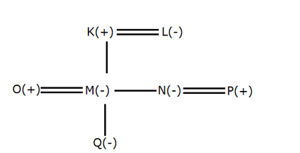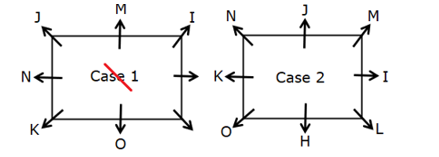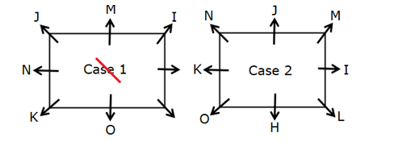Question 1:
निर्देश : निम्नलिखित जानकारी का ध्यानपूर्वक अध्ययन करें और नीचे दिए गए प्रश्नों के उत्तर दें।
Direction : Study the following information carefully and answer the questions given below.
तीन पीढ़ियों और तीन विवाहित जोड़ों वाले परिवार में सात व्यक्ति हैं। Q, M की पुत्री है, जो P की भाभी/ननद है। P का कोई भाई-बहन नहीं है। K, N का पिता है, जो Q की चाची/मामी है। O, L का दामाद है।
Seven persons are there in a family with three generations and three married couples. Q is the daughter of M, who is the sister-in-law of P. P doesn’t have any siblings. K is the father of N, who is the aunt of Q. O is the son-in-law of L.
How many male members are there in the family?
परिवार में कितने पुरुष सदस्य हैं?
Question 2:
निर्देश : निम्नलिखित जानकारी का ध्यानपूर्वक अध्ययन करें और नीचे दिए गए प्रश्नों के उत्तर दें।
Direction : Study the following information carefully and answer the questions given below.
आठ व्यक्ति - H, I, J, K, L, M, N और O एक आयताकार मेज़ के चारों ओर मेज़ के बाहर की ओर उन्मुख होकर खड़े हैं, लेकिन जरूरी नहीं कि इसी क्रम में हों। चार व्यक्ति प्रत्येक कोने पर खड़े हैं और चार व्यक्ति मेज़ की प्रत्येक भुजा के मध्य में खड़े हैं।
J, I के बाएं से दूसरे स्थान पर खड़ा है, जो मेज़ की सबसे लंबी भुजा पर नहीं खड़ा है। I और O के मध्य दो व्यक्ति खड़े हैं, जो J के आसन्न नहीं खड़ा है। O, M के विपरीत खड़ा है। M, N के दायें से दूसरे स्थान पर खड़ा है। K, N के आसन्न खड़ा है। H न तो कोने पर और न ही मेज़ की छोटी भुजा पर खड़ा है।
Eight persons - H, I, J, K, L, M, N and O are standing around a rectangular table facing outside the table, but not necessarily in the same order. Four persons are standing on each corner and four persons are standing in the middle of each side of the table.
J stands second to the left of I, who doesn’t stand on the longer side of the table. Two persons stand between I and O, who doesn’t stand adjacent to J. O stands opposite to M. M stands second to the right of N. K stands adjacent to N. H neither stands at the corner nor on the shorter side of the table.
Who among the following person stands opposite to H?
निम्नलिखित में से कौन सा व्यक्ति H के विपरीत खड़ा है?
Question 3:
निर्देश : निम्नलिखित जानकारी का ध्यानपूर्वक अध्ययन करें और नीचे दिए गए प्रश्नों के उत्तर दें।
Direction : Study the following information carefully and answer the questions given below.
आठ व्यक्ति - H, I, J, K, L, M, N और O एक आयताकार मेज़ के चारों ओर मेज़ के बाहर की ओर उन्मुख होकर खड़े हैं, लेकिन जरूरी नहीं कि इसी क्रम में हों। चार व्यक्ति प्रत्येक कोने पर खड़े हैं और चार व्यक्ति मेज़ की प्रत्येक भुजा के मध्य में खड़े हैं।
J, I के बाएं से दूसरे स्थान पर खड़ा है, जो मेज़ की सबसे लंबी भुजा पर नहीं खड़ा है। I और O के मध्य दो व्यक्ति खड़े हैं, जो J के आसन्न नहीं खड़ा है। O, M के विपरीत खड़ा है। M, N के दायें से दूसरे स्थान पर खड़ा है। K, N के आसन्न खड़ा है। H न तो कोने पर और न ही मेज़ की छोटी भुजा पर खड़ा है।
Eight persons - H, I, J, K, L, M, N and O are standing around a rectangular table facing outside the table, but not necessarily in the same order. Four persons are standing on each corner and four persons are standing in the middle of each side of the table.
J stands second to the left of I, who doesn’t stand on the longer side of the table. Two persons stand between I and O, who doesn’t stand adjacent to J. O stands opposite to M. M stands second to the right of N. K stands adjacent to N. H neither stands at the corner nor on the shorter side of the table.
How many persons stand between N and I, when counted from the right of N?
N के दायें से गिनने पर N और I के मध्य कितने व्यक्ति खड़े हैं?
Question 4:
निर्देश : निम्नलिखित जानकारी का ध्यानपूर्वक अध्ययन करें और नीचे दिए गए प्रश्नों के उत्तर दें।
Direction : Study the following information carefully and answer the questions given below.
आठ व्यक्ति - H, I, J, K, L, M, N और O एक आयताकार मेज़ के चारों ओर मेज़ के बाहर की ओर उन्मुख होकर खड़े हैं, लेकिन जरूरी नहीं कि इसी क्रम में हों। चार व्यक्ति प्रत्येक कोने पर खड़े हैं और चार व्यक्ति मेज़ की प्रत्येक भुजा के मध्य में खड़े हैं।
J, I के बाएं से दूसरे स्थान पर खड़ा है, जो मेज़ की सबसे लंबी भुजा पर नहीं खड़ा है। I और O के मध्य दो व्यक्ति खड़े हैं, जो J के आसन्न नहीं खड़ा है। O, M के विपरीत खड़ा है। M, N के दायें से दूसरे स्थान पर खड़ा है। K, N के आसन्न खड़ा है। H न तो कोने पर और न ही मेज़ की छोटी भुजा पर खड़ा है।
Eight persons - H, I, J, K, L, M, N and O are standing around a rectangular table facing outside the table, but not necessarily in the same order. Four persons are standing on each corner and four persons are standing in the middle of each side of the table.
J stands second to the left of I, who doesn’t stand on the longer side of the table. Two persons stand between I and O, who doesn’t stand adjacent to J. O stands opposite to M. M stands second to the right of N. K stands adjacent to N. H neither stands at the corner nor on the shorter side of the table.
If all the persons are made to stand in the alphabetical order from H in the anticlockwise direction, then how many persons remain unchanged in their position? (Excluding H)
यदि सभी व्यक्तियों को H से वामावर्त दिशा में वर्णानुक्रम में खड़ा किया जाता है, तो कितने व्यक्ति (H को छोड़कर) अपने स्थान पर अपरिवर्तित रहते हैं?
Question 5:
निर्देश : निम्नलिखित जानकारी का ध्यानपूर्वक अध्ययन करें और नीचे दिए गए प्रश्नों के उत्तर दें।
Direction : Study the following information carefully and answer the questions given below.
आठ व्यक्ति - H, I, J, K, L, M, N और O एक आयताकार मेज़ के चारों ओर मेज़ के बाहर की ओर उन्मुख होकर खड़े हैं, लेकिन जरूरी नहीं कि इसी क्रम में हों। चार व्यक्ति प्रत्येक कोने पर खड़े हैं और चार व्यक्ति मेज़ की प्रत्येक भुजा के मध्य में खड़े हैं।
J, I के बाएं से दूसरे स्थान पर खड़ा है, जो मेज़ की सबसे लंबी भुजा पर नहीं खड़ा है। I और O के मध्य दो व्यक्ति खड़े हैं, जो J के आसन्न नहीं खड़ा है। O, M के विपरीत खड़ा है। M, N के दायें से दूसरे स्थान पर खड़ा है। K, N के आसन्न खड़ा है। H न तो कोने पर और न ही मेज़ की छोटी भुजा पर खड़ा है।
Eight persons - H, I, J, K, L, M, N and O are standing around a rectangular table facing outside the table, but not necessarily in the same order. Four persons are standing on each corner and four persons are standing in the middle of each side of the table.
J stands second to the left of I, who doesn’t stand on the longer side of the table. Two persons stand between I and O, who doesn’t stand adjacent to J. O stands opposite to M. M stands second to the right of N. K stands adjacent to N. H neither stands at the corner nor on the shorter side of the table.
Which of the following statements is/are true with respect to the final arrangement?
अंतिम व्यवस्था के संबंध में निम्नलिखित में से कौन सा/से कथन सत्य है/हैं?
Question 6:
निर्देश : निम्नलिखित जानकारी का ध्यानपूर्वक अध्ययन करें और नीचे दिए गए प्रश्नों के उत्तर दें।
Direction : Study the following information carefully and answer the questions given below.
आठ व्यक्ति - H, I, J, K, L, M, N और O एक आयताकार मेज़ के चारों ओर मेज़ के बाहर की ओर उन्मुख होकर खड़े हैं, लेकिन जरूरी नहीं कि इसी क्रम में हों। चार व्यक्ति प्रत्येक कोने पर खड़े हैं और चार व्यक्ति मेज़ की प्रत्येक भुजा के मध्य में खड़े हैं।
J, I के बाएं से दूसरे स्थान पर खड़ा है, जो मेज़ की सबसे लंबी भुजा पर नहीं खड़ा है। I और O के मध्य दो व्यक्ति खड़े हैं, जो J के आसन्न नहीं खड़ा है। O, M के विपरीत खड़ा है। M, N के दायें से दूसरे स्थान पर खड़ा है। K, N के आसन्न खड़ा है। H न तो कोने पर और न ही मेज़ की छोटी भुजा पर खड़ा है।
Eight persons - H, I, J, K, L, M, N and O are standing around a rectangular table facing outside the table, but not necessarily in the same order. Four persons are standing on each corner and four persons are standing in the middle of each side of the table.
J stands second to the left of I, who doesn’t stand on the longer side of the table. Two persons stand between I and O, who doesn’t stand adjacent to J. O stands opposite to M. M stands second to the right of N. K stands adjacent to N. H neither stands at the corner nor on the shorter side of the table.
If K is related to O and H is related to L in a certain way, then who among the following person is related to M?
यदि एक निश्चित तरीके से K, O से संबंधित है और H, L से संबंधित है, तो निम्नलिखित में से कौन सा व्यक्ति M से संबंधित है?
Question 7:
If all the digits of the given number “7654323458765” are arranged in the ascending order from left to right, then how many digits remain unchanged in its position?
यदि दी गई संख्या “7654323458765” के सभी अंकों को बाएं से दाएं आरोही क्रम में व्यवस्थित किया जाए, तो कितने अंक अपने स्थान पर अपरिवर्तित रहेंगे?
Question 8:
If all the letters of the word “COMMUNICATION” is changed to the next letter as per the English alphabetical series, then how many vowels are there in the word thus formed?
यदि शब्द "COMMUNICATION" के सभी अक्षरों को अंग्रेजी वर्णमाला श्रृंखला के अनुसार अगले अक्षर में बदल दिया जाता है, तो इस प्रकार बने शब्द में कितने स्वर हैं?
Question 9:
निर्देश : निम्नलिखित जानकारी का ध्यानपूर्वक अध्ययन करें और नीचे दिए गए प्रश्नों के उत्तर दें।
Direction : Study the following information carefully and answer the questions given below.
छह व्यक्तियों - T, U, V, W, X और Y ने एक परीक्षा में अलग-अलग अंक प्राप्त किए। केवल दो व्यक्तियों ने V से कम अंक प्राप्त किए। U ने W से अधिक अंक प्राप्त किए। X जो सबसे कम अंक प्राप्त नहीं करता है लेकिन W से कम अंक प्राप्त करता है। T ने U से अधिक अंक प्राप्त किए। W ने 60 अंक प्राप्त किए।
Six persons - T, U, V, W, X and Y secured different marks in an exam. Only two persons secured less marks than V. U secured more marks than W. X who doesn’t secure the lowest mark but secured less marks than W. T secured more marks than U. W secured 60 marks.
Who among the following person secured the lowest mark?
निम्नलिखित में से किस व्यक्ति ने सबसे कम अंक प्राप्त किए हैं?
Question 10:
निर्देश : निम्नलिखित जानकारी का ध्यानपूर्वक अध्ययन करें और नीचे दिए गए प्रश्नों के उत्तर दें।
Direction : Study the following information carefully and answer the questions given below.
छह व्यक्तियों - T, U, V, W, X और Y ने एक परीक्षा में अलग-अलग अंक प्राप्त किए। केवल दो व्यक्तियों ने V से कम अंक प्राप्त किए। U ने W से अधिक अंक प्राप्त किए। X जो सबसे कम अंक प्राप्त नहीं करता है लेकिन W से कम अंक प्राप्त करता है। T ने U से अधिक अंक प्राप्त किए। W ने 60 अंक प्राप्त किए।
Six persons - T, U, V, W, X and Y secured different marks in an exam. Only two persons secured less marks than V. U secured more marks than W. X who doesn’t secure the lowest mark but secured less marks than W. T secured more marks than U. W secured 60 marks.
If the sum of the marks secured by X and the one who secured the third highest mark is 100, then what might be the mark secured by V?
यदि X और तीसरे उच्चतम अंक प्राप्त करने वाले व्यक्ति द्वारा प्राप्त अंकों का योग 100 है, तो V द्वारा प्राप्त अंक क्या हो सकते हैं ?






